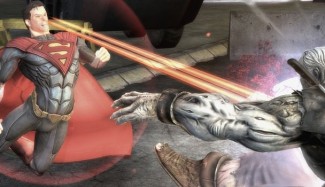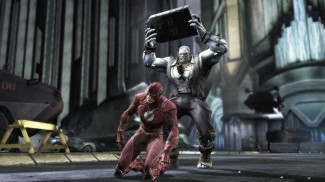Bastion
LQ: 9.15
Recommended Age: 10+
Skills Used: Planning, Working Memory, Mathematics, Reading

Injustice: Gods Among Us puts a new spin on familiar super heroes and villains while adding exciting new features to the fighting genre. Players follow an immersive storyline that blurs the lines between good and evil characters as members of the Justice League are forced to work together with former villains to defeat a greater threat. Players will work their way through a number of movie-like cutscenes, fighting and defeating minor enemies as well as more challenging bosses along the way. The game requires players to learn and recall a number of button-combinations, react quickly to attacks, and use creativity with their surrounding environment to defeat their foes. Players may also take on friends and family members using a multiplayer mode that allows two players to duke it out on a single console, or over an internet connection. Injustice: Gods Among Us is available on game consoles in a full edition, as well as in a lighter, free version for iOS devices. Players can unlock features in either the console or mobile versions and use them across both platforms. This game contains moderate violence and depicts injuries to characters and uniforms containing small amounts of blood. The story-mode includes mature language some female characters wear revealing outfits that parents may find inappropriate. This game is recommended only to player ages 14 and up.
Teachers: check out the classroom guide!
Adapting and adjusting to changing conditions and expectations.
 Injustice requires a great deal of flexibility from players who must not only learn to play using multiple characters and control schemes, but also learn the fighting styles, moves, and special attacks of their enemies. Each character is unique and requires players to quickly alter and adapt their strategies, especially with each new enemy. Enemies utilize a number of unique attacks and strategies which can be countered, blocked, or avoided by players if they are quick to react and adapt to their foe. Players who are able to quickly learn new controls, button combinations, and fighting styles will far outperform those who cannot. In addition, players must be able to identify their own strengths and weaknesses, as well as those of their enemies, in order to capitalize on or exploit these opportunities. Fights are numerous, vary widely, and approach quickly, maximizing the need for the Flexibility thinking skill.
Injustice requires a great deal of flexibility from players who must not only learn to play using multiple characters and control schemes, but also learn the fighting styles, moves, and special attacks of their enemies. Each character is unique and requires players to quickly alter and adapt their strategies, especially with each new enemy. Enemies utilize a number of unique attacks and strategies which can be countered, blocked, or avoided by players if they are quick to react and adapt to their foe. Players who are able to quickly learn new controls, button combinations, and fighting styles will far outperform those who cannot. In addition, players must be able to identify their own strengths and weaknesses, as well as those of their enemies, in order to capitalize on or exploit these opportunities. Fights are numerous, vary widely, and approach quickly, maximizing the need for the Flexibility thinking skill.
Recalling and retaining information in our mind while working.
Fighting games inherently require exercising the Working Memory thinking skill as players must remember a large number of controls, combinations or controls, and other important knowledge to defeat their enemies. As with other games in this genre, the Injustice storyline puts players into the shoes of numerous characters, each with a unique skill-set, weapon, and control scheme. Players must learn how to control their character, when and where to deploy different styles of attack and defense, while simultaneously learning and remembering the important moves of their enemies. For example, when playing as Batman, players must learn his close-range attacks, grapples, ranged attacks, and special moves unique to the character. When switching to the next playable character, Green Lantern, players must learn an entirely new style of play and control scheme in order to succeed.
Being efficient and aware of our use of time and effort.
 Both multiplayer and storyline fights in Injustice are timed affairs. Players must be able to manage their strategy of attack and defend based on ticking clock. If the fight is not won in a deciding "knock out," whichever player has a greater health total at the expiration of the clock automatically wins the battle. Players must be aware of both their own and their opponents health levels, as well as the amount of time remaining in the battle, altering strategies as necessary. For example, when fighting against a particularly powerful opponent, who is slow moving, with little time left players are better served by blocking and working to avoid their enemy than confronting him head on. Conversely, in situations where time is quickly expiring and players have less health than their enemy, they may need to take on a more aggressive strategy to defeat their enemy before time runs out.
Both multiplayer and storyline fights in Injustice are timed affairs. Players must be able to manage their strategy of attack and defend based on ticking clock. If the fight is not won in a deciding "knock out," whichever player has a greater health total at the expiration of the clock automatically wins the battle. Players must be aware of both their own and their opponents health levels, as well as the amount of time remaining in the battle, altering strategies as necessary. For example, when fighting against a particularly powerful opponent, who is slow moving, with little time left players are better served by blocking and working to avoid their enemy than confronting him head on. Conversely, in situations where time is quickly expiring and players have less health than their enemy, they may need to take on a more aggressive strategy to defeat their enemy before time runs out.
All membership plans come with full access to our entire suite of tools learning guides, and resources. Here are a few of the ones we think you’ll like the most: